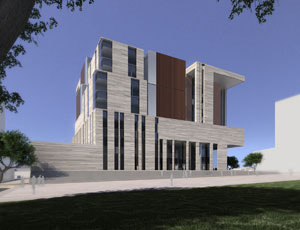Construction of a new, $107-million United States District Courthouse building on a long-dormant block in rapidly redeveloping downtown Austin will soon get under way thanks to federal stimulus funds.
Funding from the American Recovery and Reinvestment Act also allowed the project’s original construction timetable to be moved up.

White Construction Co. of Austin signed on in March 2004 as construction-manager-as-constructor for the design and preconstruction phase on the seven-story, 211,590-sq-ft structure (with one level of underground parking). “We were told at the time that it would probably not be until March 2010 before construction would begin because of congressional funding,” says Bill Farnum, White’s vice president of preconstruction. “So it’s actually moved forward about six to eight months.”
The U.S. General Services Administration expects to award White a notice to proceed by July 31, with groundbreaking likely to begin in August. The project’s completion date is set for 34 months later.
The block at Fifth and San Antonio streets has been the subject of local controversy since high-tech company Intel Corp., Santa Clara, Calif., stopped construction on a 10-story, $124-million microchip design center on the site in February 2001 and left only a four-story steel shell and concrete decks. The federal government bought the property from Intel in January 2004 for $8.89 million.
For six years after Intel ceased work on the building, various civic groups expressed concerns about the unfinished project. Prior to the demolition of the shell in February 2007, Austin Mayor Will Wynn attempted to broker the sale of the site to a private developer for $13 million to speed its development. Wynn also requested that the demolition be delayed and an alternate location for the courthouse be considered.
But the GSA declined to accept the informal offer, citing the investment already made in site acquisition, design and planning. The shell was demolished as scheduled at a cost of $1.3 million.
Construction was originally budgeted at $65-million and is now set at $107 million, including construction contingency funds but not property price and demolition cost. GSA project manager Dale Sherman cites the rising prices of materials and transportation for the higher cost. An additional $9.1 million of stimulus funds will cover the costs of the onsite GSA project management agent and architect’s representative, Sherman says.
The 135-ft-tall, cast-in-place concrete building was designed by Mack Scogin Merrill Elam Architects of Atlanta with Austin architects Page Southerland Page as local consultants. It will house eight courtrooms and jury assembly rooms and offices for the district clerk, federal attorney and public defender as well as probation, pretrial and marshal services and the GSA.
| Sector | Public |
|---|---|
| State | Texas |
| Description | United States District Courthouse |
| Values | $107 million |
| Owner | Federal government |
| Jobs | 200 |
| General Contractor | White Construction Co., Austin |
| Start Date | July 31 |
Sherman and Farnum say the project’s tight downtown site is the biggest obstacle. Sherman adds that multiple-level shoring for some of the upper floors is another issue. “It has a complicated floor plate,” he says. “As you go up in the structure, the floor plate rotates. The courtrooms go from one side of the building to the other.”
Farnum says the rotating floor plate and extra shoring are “just part of building a building.”
White recently gave recommendations to the GSA and the city of Austin for offsite staging locations and is awaiting selection and permissions. “The city is literally pouring its heart out to help us,” Farnum says.
The building’s exterior is primarily Texas limestone with glass curtain wall and some metal panels. The interior will feature a two-story atrium that extends to the third floor. “It’s a fairly austere building in a lot of respects,” Sherman says.
The project is designed for LEED silver certification.


Post a comment to this article
Report Abusive Comment